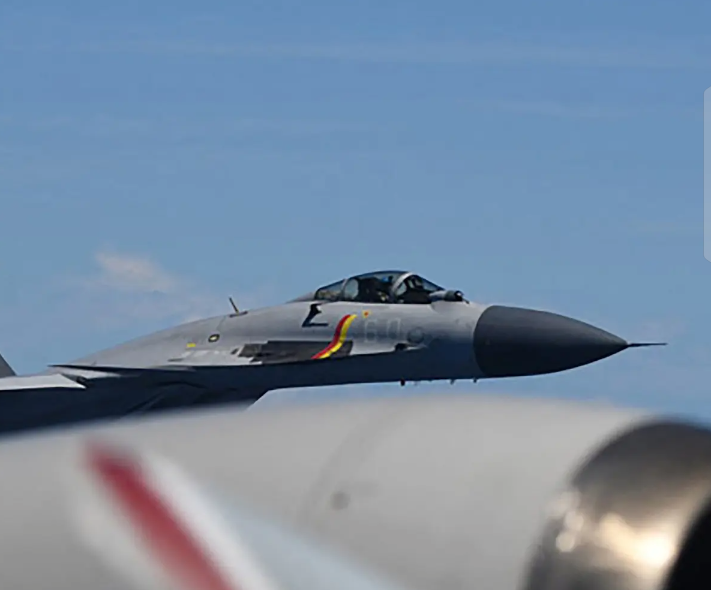
Close Call Over Pacific: Japan Warns China After Fighter Jet Buzzes Military Plane

Tensions in the Asia-Pacific region surged over the weekend after a Chinese fighter jet flew dangerously close to a Japanese military aircraft over international waters, prompting Tokyo to issue a stern warning to Beijing. The encounter, which occurred during a series of Chinese naval drills in the Pacific Ocean, is being described by Japanese officials as a serious provocation that could have ended in disaster.
According to Japan’s Ministry of Defense, the incident unfolded as a Japanese P-3C patrol plane was conducting routine surveillance operations over international airspace in the Pacific. On Saturday, a Chinese J-15 fighter jet approached the Japanese aircraft to within just 150 feet—an alarmingly short distance by military aviation standards. The following day, the same Chinese jet cut across the front of the Japanese plane at a distance of approximately 3,000 feet. While the P-3C is an anti-submarine patrol aircraft, the J-15 is a highly maneuverable fighter jet that appeared to be armed with missiles, according to Japanese officials.
The Chinese aircraft is believed to have launched from the Shandong, one of China’s two operational aircraft carriers. The Shandong and its sister carrier, the Liaoning, were conducting joint military exercises far from China’s coastline—the first such coordinated naval drill of its kind in these distant waters. Analysts say the exercises are a powerful demonstration of Beijing’s growing ability to project military power across the Asia-Pacific.
“Japan expressed a serious concern and requested a prevention of reoccurrence of such incidents as it could trigger accidental collisions,” Gen Nakatani, Japan’s defense minister, said during a security committee session at the National Diet, Japan’s parliament. The Defense Ministry's formal statement emphasized the potentially catastrophic consequences of such close encounters in the sky and reiterated the importance of safe, professional conduct between military forces operating in international airspace.
Gen. Yoshihide Yoshida, Chief of the Joint Staff for Japan’s Self-Defense Forces, further emphasized the gravity of the situation. He told reporters that it was difficult to determine whether the Chinese jet’s aggressive maneuvering constituted a direct threat or was simply reckless, but that either scenario posed a major risk. “Such behavior significantly increases the chances of an accident,” he said, pointing to a broader trend of increasingly erratic military movements by China in the region. “They have been making unusual maneuvers intermittently and continuously.”
China’s response has been both defensive and deflective. Lin Jian, a spokesperson for China’s Ministry of Foreign Affairs, insisted on Thursday that China was not to blame for the incident. At a press conference in Beijing, Lin argued that Japan’s own actions were the root cause of the close encounter. “Let me stress that the close maneuvers of the Japanese airplanes against China is the fundamental reason of such a situation,” he said. “We hope that Japan will view the activities objectively and rationally.” The comment underscores the vast gulf between the two nations’ perspectives, and further complicates already strained diplomatic relations.
Experts say the encounter is a reflection of growing military assertiveness by China, which has stepped up its presence not only in the East China Sea—where it has longstanding territorial disputes with Japan over the Senkaku/Diaoyu Islands—but also across broader regions of the Pacific and South China Sea. The timing of this latest incident is particularly sensitive, coming amid efforts by regional allies, including the United States, to reinforce military ties and deter Chinese aggression.
This is not the first time a near-miss involving China’s military has made international headlines. In 2022, a Chinese fighter jet flew within 20 feet of a U.S. military aircraft over the South China Sea in what the Pentagon described as a dangerously close encounter that nearly caused a collision. The most tragic example remains the 2001 collision between a U.S. Navy EP-3 surveillance plane and a Chinese fighter jet, which resulted in the death of the Chinese pilot and forced the American aircraft to make an emergency landing on Hainan Island. That incident led to a prolonged diplomatic standoff between Washington and Beijing, highlighting just how quickly such incidents can escalate.
As the Pacific becomes increasingly crowded with military aircraft and naval vessels, the risk of a similar event spiraling into a full-blown crisis looms large. Both Japan and China maintain that they are conducting legal and necessary operations, yet their definitions of acceptable behavior appear to diverge sharply. The fact that these encounters are taking place over international waters only adds to the complexity, as neither side can claim exclusive rights to the airspace.
While both governments have acknowledged that communication is ongoing between their respective defense ministries, analysts caution that mere dialogue may not be sufficient to prevent future incidents. There are growing calls among international observers for a formalized set of air-to-air engagement rules between regional powers—similar to the Code for Unplanned Encounters at Sea (CUES), which some navies have signed but does not extend comprehensively to air operations.
For now, Japan’s warning stands as a stark reminder of how precarious the current security environment is in the Indo-Pacific. With China's military capabilities growing and its willingness to assert those capabilities expanding, incidents like the one last weekend may become more common—and more dangerous.
As both sides dig in and defend their actions, the potential for escalation cannot be ignored. The skies above the Pacific are becoming a theater not just for surveillance and deterrence, but for geopolitical gamesmanship where a single miscalculation could lead to tragedy. Whether Beijing and Tokyo can agree on new safety protocols—or whether they will continue to test each other's limits—remains a pressing question for the region and the world.


